Lessons & Units
A database
of lessons and units searchable by content and cultural standards,
cultural region and grade level. More units will be available soon.
You can use Acrobat Reader to look at the PDF version of the Cover
Sheet
for the Units and Self-Assessment
for Cultural Standards in Practice.
BIRDS
Lesson 1 What is a Bird?
Objectives:
1) Students will describe the main
characteristics of a bird.
2) Students will label the different parts of a
bird.
3) Students will tell why different types of
birds have different shaped bodies, wings and tails, beaks, feet
and how these adapt each type of bird to its way of
life.
4) Students will answer the question "How do
birds fly?"
Activities:
1) Brainstorm about "What is a bird?" and
how it differs from other animals. What special characteristics
enable birds to fly? Refer to the page "How Birds Fly" and have
students try the experiment.
2) Make a chart to compare birds with another
example of local wildlife such as a mouse, squirrel or rabbit. How
are they alike; how are they different?
3) Have each student draw a bird and label its
parts. Then compare the drawings with the one from Alaska's
Birds, pg. 5.
4) Look at the sketches of the different types
of beaks, feet, wing shapes and tail shapes for different birds
(Alaska's Birds, pg. 7-9). Discuss the purpose/advantage of
the variations. Do "Feet Are Neat."
5) Discuss why it is important that
birds are light in weight. Have students look at chicken bones.
(If you soak the bones in vinegar for several weeks beforehand,
the bones will be soft enough for the students to cut.) Point out
that the hollow bones reduce weight. Struts in some of the bones
help strengthen the bones without adding much extra
weight.
Assignment: Ask students to collect samples
of as many different kinds of feathers as they can find and bring
them to school.
from BIRDS AND WETLANDS OF ALASKA
2C
How Birds Fly
Like airplanes, birds are
streamlined and are built of light materials so that they can lift
easily in the air. Feathers point backward. Bills are lighter and
more streamlined than the heavy jaws of mammals and reptiles. Most
bird bones are hollow and filled with air from the bird's lungs. Even
the wishbone is hollow. Next time you eat chicken or duck, look at
the hollow bones.
Birds move through the air by
pulling themselves forward like a person rowing a boat. They
push air down and back with the broad side of the wing, then slightly
turn and fold the wing to move it forward. Some birds with great,
broad wings can soar and glide for long periods without flapping.
Other birds have short wings and have to flap fast to stay up. Bird
wings and airplane wings have a similar shape. This shape causes an
airfoil that provides lift.

TRY THIS EXPERIMENT
|
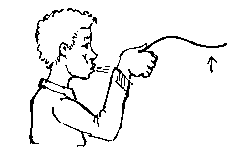
|
Hold a piece of paper like this and blow under it. The
force of the wind will push it up.
|
|
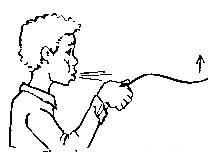
|
Now blow across the
top of the paper and watch it lift.
|
The slow moving air under the paper forces the paper up through
the fast moving air on top of the paper, creating lift.
From ALASKA'S BIRDS
Parts of a Bird: First, learn the
different parts of a bird. When you see a
bird, try to notice what color and shape each part of the bird is. For example,
if you saw
the bird shown below, you might say it was brown. But if you looked
at it carefully, you would notice its back, wings, and tail are
brown, but its crown is black and white, its bill, legs, and feet are
orange, and its breast and belly are light gray.
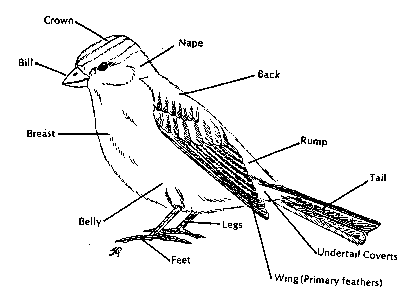
Bird Wings:
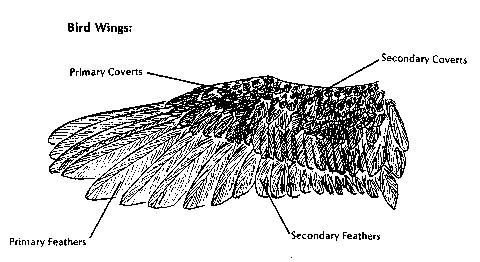
from ALASKA'S BIRDS
Bill shape is a good
identification clue. You can also tell a lot about a bird's feeding
habits by the shape of its bill.
|

|
Insect eaters have slender, pointed bills
(flycatchers, warblers, thrushes, and swallows).
|
|

|
Seed eaters
have short, stout, cone-shaped bills for cracking seeds
(pine grosbeaks, redpolls, and sparrows).
|
|
Woodpeckers
have strong, straight, chisel-like bills for drilling into
wood to catch insects.
|

|
|

|
Mud probers
have long, slender bills for catching animals in the mud
(dunlins, yellowlegs, and other sandpipers).
|
|
Water strainers
have spoon-like bills with edges that strain food from the
water (mallards, pintails, shovelers, and
wigeons).
|

|
|
Fish eaters
often have long, sharp bills for catching or spearing fish
(kingfishers, grebes, loons, and mergansers).
|

|
|

|
Birds of prey or "raptors" have strong,
hooked beaks with sharp edges (eagles, hawks, owls, and shrikes).
|
from ALASKA'S BIRDS
Legs and feet. The
length of a bird's legs and shape of its feet are also clues to bird
identification. Leg and feet shapes also provide information about
where a bird lives, how it captures its food, and how it moves from
place to place.
|

|
Wading birds
have long legs and toes (yellowlegs and great blue
herons).
|
|

|
Perching birds
have toes for grasping. Pressure on the inside of the foot
causes the toes to lock around a perch. That is how
chickadees can sleep without falling off the
branch.
|
|

|
Swimming birds
like ducks, puffins, and loons have webbed feet for paddling
in water. Grebes are also swimming birds, but their feet are
lobed.
|
|

|
Tree climbers
have wide-spread toes with curved claws. Some woodpeckers
have two toes in front and two toes in back. Three-toed
woodpeckers have two toes in front and one in
back.
|
|

|
Birds of prey
like hawks, owls, and eagles have strong legs and feet with
sharp, hooked claws to grasp and carry prey.
|
|

|
Ground feeders
like sparrows and juncos often scratch the ground for food.
Their feet have three forward toes and one hind
toe.
|
From ALASKA'S BIRDS
Wing shapes are good
indicators of flight style. Both wing shape and flight patterns are
clues to identification.
|

|
Pointed wings
are found on fast-flying birds like falcons and
swallows.
|
|

|
Short, rounded
wings are good for quick takeoff but short flights.
Grouse and sparrows have this type of wing.
|
|

|
Long, broad
wings are soaring wings like those of hawks and
eagles.
|
Tail shape indicates how
a bird flys.
|

|
A long, forked
tail is for steering during fast flight. Swallows use
their forked tails to make quick dips and turns while
chasing insects.
|
|

|
A stiff tail
provides leverage for tree climbers. Woodpeckers use their
tail for support when they peck tree trunks in search of
insects.
|
|

|
A broad, rounded
tail is typical of soaring birds like hawks.
|
|

|
A long, narrow
tail is typical of falcons and acts as a rudder during
swift dives.
|
|
Copycat Page
|
Feet Are Neat
|

|
These birds all have the wrong feet!
In the blank next to each bird, write the number that represents the "right" feet.
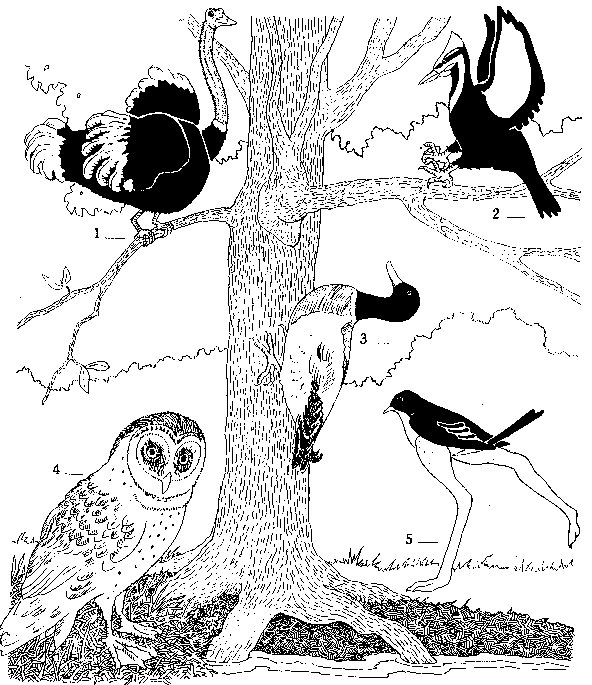
RANGER RICK'S NATURESCOPE: BIRDS, BIRDS,
BIRDS!
Handbook
for Culturally Responsive Science Curriculum by Sidney Stephens
Excerpt: "The information and insights contained in this document will be
of interest to anyone involved in bringing local knowledge to bear in school
curriculum. Drawing upon the efforts of many people over a period of several
years, Sidney Stephens has managed to distill and synthesize the critical ingredients
for making the teaching of science relevant and meaningful in culturally adaptable
ways." |